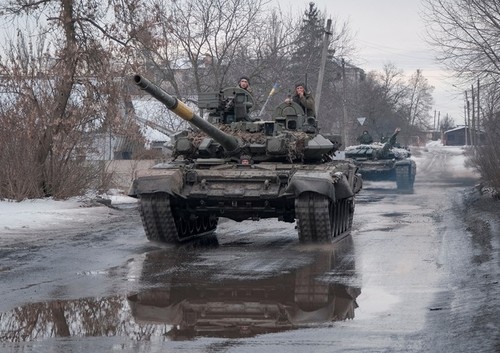 Ukraine's tanks go near Bakhmut city, Donetsk province on February 21, 2023. (Photo: Reuters) Ukraine's tanks go near Bakhmut city, Donetsk province on February 21, 2023. (Photo: Reuters) |
In a live speech on February 24, 2022, before launching the "special military operation" in eastern Ukraine, President Putin said that in response to a call for assistance to ensure security from the leaders of the two self-proclaimed Republics of Donestsk and Lugansk, Russia's special military operation is for self-defense. Russia will not occupy Ukraine but will "de-fascist" and "demilitarize" the country. The Russia-Ukraine conflict, the worst conflict in Europe since World War II, has escalated from that moment until now.
Heavy losses
The current armed conflict is the culmination of a series of events that have been unfolding over many years, including violent protests in Ukraine that resulted in the overthrow of President Victor Yanukovich in February, 2014, Moscow's annexation of Ukraine’s Crimea region the following month, the Lugansk and Donetsk regions of Ukraine declaring themselves independent states the same year, and Ukraine’s plan to join the NATO alliance.
Over the past year, Russia has expanded its special military operation in Ukraine, going so far as to launch attacks on the capital Kiev and other Ukrainian cities. The conflict has done severe damage to the economies of Russia and Ukraine, and most of the rest of the world.
The world is now facing a serious food crisis, with supplies of wheat and other grains from two of the world’s major suppliers greatly reduced. Fuel supply disruptions caused by mutual sanctions between Moscow and the West has made this winter a cold one in Europe, raised global energy prices, pushed up inflation in many countries to record levels, and led to social unrest.
The conflict has also caused the largest humanitarian crisis in Europe since World War II. The UN High Commissioner for Human Rights has reported more than 18,000 people killed, 7.9 million people fled to other European countries, and 21.8 million people desperately in need of humanitarian assistance.
Dangerous developments
Since the beginning of the year, western countries have been increasing military aid to Ukraine. The EU and NATO have pledged to send more weapons and ammunition to Kiev, and the EU is discussing a 10th package of sanctions against Moscow.
Ukrainian President Volodymyr Zelensky said recently that Kiev's goal is not only to resist new attacks from Russia, but to regain all the territory already taken by Russia, including Crimea. Ukraine is calling on its Western allies to send more aid as quickly as possible.
The door to peace remains closed
"Condemn", "appeal ", and "urge" are words frequently repeated over the last year by many countries and organizations, but words have been unable to get Russia and Ukraine to put down their weapons. The US, the EU, and their allies have imposed some 11,000 finance, trade, technology, and energy sanctions against Russia and Russian oligarchs.
Analysts say a diplomatic agreement to end the conflict seems unlikely in the near future. Russia and Ukraine are far apart on many issues. The US and some European countries have urged more dialogue while steadily delivering weapons to Ukraine and tightening sanctions against Russia.
UN General Assembly President Csaba Kőrösi on Thursday warned that the Russia-Ukraine conflict is escalating and the prospect for peace is diminishing.